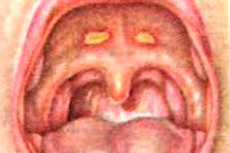Medical expert of the article
New publications
Bednar's aphthae in children
Last reviewed: 04.07.2025

All iLive content is medically reviewed or fact checked to ensure as much factual accuracy as possible.
We have strict sourcing guidelines and only link to reputable media sites, academic research institutions and, whenever possible, medically peer reviewed studies. Note that the numbers in parentheses ([1], [2], etc.) are clickable links to these studies.
If you feel that any of our content is inaccurate, out-of-date, or otherwise questionable, please select it and press Ctrl + Enter.

The mysterious word "aphthae" translated from Greek means ulcers on the surface of the mucous membranes. Bednar's aphthae are erosions in the mouth, mainly in newborns, rarely in older children. Most often, premature babies, weakened babies and children from disadvantaged families, where proper attention is not paid to oral hygiene, are susceptible to the disease. [ 1 ]
Causes Bednar's aft
One of the main causes of damage in the mouth is constant trauma to the mucous membrane due to:
- rough skin of the nipple (occurs when cracks heal);
- too tight latex nipples;
- use of non-orthodontic pacifiers;
- wiping the mouth after feeding with a hard material (bandage, gauze). [ 5 ]
Other risk factors for the formation of canker sores include non-sterile bottles, the reflex to put various objects in the mouth, and the consequences of other diseases (flu, celiac disease, [ 6 ] gastrointestinal diseases, etc.).
A study by Bessa et al. [ 7 ] found that the causes of Bednar's aphthae are: lesions of the oral mucosa (24.9%), malocclusion (4.7%). A study by Bezerra and Costa [ 8 ] shows that 2.3% of children aged 0 to 5 years had lesions of the oral mucosa, consisting of Bohn's nodules (37%), candidiasis (25%) and geographic tongue (21%).
Pathogenesis
Aphthae caused by trauma go through the stage of blister formation, rupture, inflammation and tissue necrosis, covering the defect with a whitish coating of fibrin - the end product of blood clotting - an insoluble fibrous protein that closes the wound and promotes its healing.
The pathogenesis of other forms (herpetic, recurrent stomatitis, etc.) is associated with the etiology of these pathologies.
More recent reports suggest a new hypothesis about the pathogenesis of Bednar's aphthae as a consequence of an immune process.[ 9 ]
Symptoms Bednar's aft
The first signs of Bednar's aphthae in children are expressed in a particular restless and excited behavior. During breastfeeding, touching them with the nipple causes pain, the child stops and cries.
They are clearly visible in the mouth with the naked eye. The characteristics of Bednar's aphthae are as follows: located between the hard and soft palate, have an irregular oval shape, outlined by a red inflamed rim, are symmetrical in relation to each other, covered with a loose yellow-gray coating, soft to palpation. [ 10 ]
Complications and consequences
They usually heal spontaneously within one month without complications.
Mouth ulcers heal, but if the process is prolonged, this can affect the supply of nutrients to the baby's body, since due to pain during feeding, the baby does not fully receive the necessary dose of mother's milk.
The addition of a secondary infection can provoke ulcers and even perforation of the palate.
Diagnostics Bednar's aft
The diagnosis is made on the basis of the anamnesis and characteristic clinical picture.
A smear test taken from the surface of the aphtha and serodiagnostics help to identify the disease.
Treatment Bednar's aft
When Bednar's aphtha is diagnosed, the damaging factor is eliminated first: the correct nipple is selected, special breast pads are used to prevent rough areas of the breast from coming into contact with the baby's mouth, and bottles are sterilized.
Treatment consists of treating oral erosions from plaque with such preparations as trypsin, chymotrypsin, lysozyme (the bandage is soaked in a 0.05% solution); for this purpose, proteolytic enzyme applications can be used for 10 minutes. This is followed by treatment with antiseptics of plant origin (chamomile, sage, St. John's wort decoctions) and tissue regeneration accelerators (rosehip oil, sea buckthorn).
Pain is relieved with local remedies: anesthesin ointment, lidocaine.
Prevention
Preventive measures concern raising parents’ awareness of how to behave with a newborn, how to follow the rules of breastfeeding and artificial feeding, and how to properly treat nipples.
Wiping a child's mouth for preventive purposes is not required. Older children should be weaned from the habit of putting foreign objects in their mouths.
Forecast
The prognosis for this pathology is favorable, although healing sometimes does not occur very quickly.
Использованная литература

